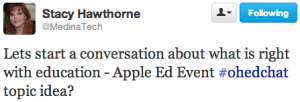Jack: I'll bet you anything you like that half an hour after they have met, they will be calling each other sister.
Algernon: Women only do that when they have called each other a lot of other things first.
― Oscar Wilde, The Importance of Being Earnest
It is 9:34, and I am ready to go to sleep, but I know my night isn’t quite over yet. Wait for it. . .I open my iPad, balance it on my stomach while lying flat on my back, and now:
“I’m so upset about my class today.”
“What is wrong?”
And the conversation begins. My blended learning support group consistently meets at this time most nights. Our iPad/texting/computer conversations sometimes continue for hours. We are keyed up, and while we are exhausted, we can’t sleep. Sometimes we are flush with victory:
“My students completed their group presentations, and two principals were there to observe them!”
Sometimes we are flush with shame. . . and booze. Lots of booze.
“Seriously, does anyone know what proofreading is? $@#!SNOOKLEDORP!!!!!”
“I told you not to use the ALL CAP SLAP!!!! STOP YELLING AT ME ONLINE!!!!”
I’m just kidding about the booze part. Maybe.
One day last year Fate threw us four women together, and as Erich Maria Remarque would say, “Camaraderie is one of the best things to come out of the war.” By necessity, Christina, Shannon, and I would discuss our lack of knowledge about Blended Learning, and we soon (again, by necessity) came to a place where we realized there was no judgment, no competition among us. We realized very early in the game that we are all deer in headlights, and this idea of Blended Learning was a huge Mack truck that was quickly bearing down on us. We realized that the only way to survive this experience was to stick together, and that is what we’ve done.
Stacy is our biggest supporter. She is more than a tech administrator; she is the lifeline for our program. She encourages us in our growth, she keeps us from making foolish decisions along the way (“No, you really can’t punch your administrator.”), and she of course gets us whatever tech support we need even before we know we need it. Stacy established our Monday afternoon meetings right from the start,and we certainly didn’t realize how much we would need or look forward to them. In these meetings, we complain, we argue, we cry. . .we innovate, we create, we experiment, and we laugh. Thank goodness, we laugh a lot.
Christina, Shannon, and I are lucky in the fact that our classrooms are very close to each other. Every fifty minutes, I know that I will step into the hall (to monitor the class changes), and I will be able to talk to one or both of them. Sometimes it’s a quick reassurance (“Get in there--you’re doing a great job”), and sometimes it’s a technical problem. I can’t tell you how many times one or all of us dropped everything we were doing to help out with a Blackboard, iPad, or Apple TV issue. Our students believe that we are a package deal. Beware; if you complain about one of these teachers in front of the other two, you will get an earful.
At one of our Monday meetings, an administrator wanted to discuss Christina’s course with her alone. He meant it in the kindest, most considerate way; he didn’t want to embarrass her. Christina got up from the table, closed the door to the classroom, and said, “These are my sisters. What you say to me, you say to them. We are a team.”
She is right. We are sisters; we are a team. We share our pain, our joy, our defeats, our victories. This is the only way to create a Blended Learning course; this is the best way to teach.
Those of you who know me have figured out by now that I am writing this post under the effects of an eleven mile run (see my running blog post about endorphins). Do not worry; in a few hours I will be back to yelling at you, shaking my finger at you, and telling you what to do. Then, I will turn on my iPad at 9:34, and I will wait for our next collaborative session. I might have a drink first.

 Earlier this week, I tweeted that we should focus more on what is good in education instead of what is wrong with education. Little did I know when I sent that tweet that I would be challenged to write a blog post on my thoughts. But it is this exact challenge that is central to what is good in education. We all know teachers who come to school every day to challenge and inspire students. They put aside the politics, the testing, the outside pressures, and choose to challenge and inspire students to become lifelong learners. If you know a teacher like this, and I suspect that you do, today would be a great day to let them know that they are central to what is right in education today.
Earlier this week, I tweeted that we should focus more on what is good in education instead of what is wrong with education. Little did I know when I sent that tweet that I would be challenged to write a blog post on my thoughts. But it is this exact challenge that is central to what is good in education. We all know teachers who come to school every day to challenge and inspire students. They put aside the politics, the testing, the outside pressures, and choose to challenge and inspire students to become lifelong learners. If you know a teacher like this, and I suspect that you do, today would be a great day to let them know that they are central to what is right in education today.
